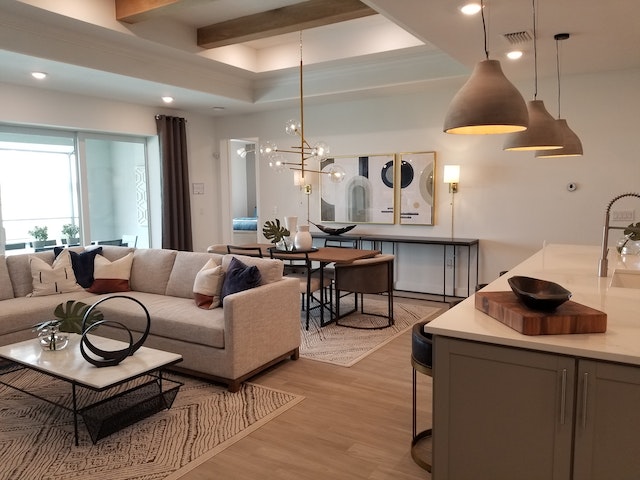Imagine, if you will, you want to sell your home. You want to get as much as you can, and you don’t want risk it sitting on the market forever. You talk with your Realtor® and they discuss the importance of pricing, professional photography and even video. You can’t help but wonder if there is something else that can be done to help get top dollar for your home. Well, there is, and it is called staging. I’ll explain.
In the real estate business when we say “home staging” or to have a home “staged” we mean have a professional service come in to furnish and style a home for the specific purpose of selling.
This is not the same as preparing a home to sell where you declutter, remove personal items like family pictures and hide the litter box. This is hiring an actual design professional who brings in furniture and decorations to set up the home specifically to sell.
A professional stager can take a cold empty home and make it look stylish and inviting. They employ the same techniques used for decades by new home developers. By staging, you can make your property as inviting as a developer’s model home.

Here we are going to talk about why you would, or sometimes not, stage a home and the logistics of how staging generally works. We will also discuss how to find the right stager and things you need to consider when doing so. This is not about how to stage a home. Home staging is a very specific niche of interior design. It is better to consult with a professional designer to learn more about the specific design techniques involved.
Why Stage a Home?
Eight Reasons to Have Your Home Staged
1) Higher price – most Realtors® agree as reflected in studies from NAR, staged homes sell for a higher price than homes that have not been staged. Let’s face it, when you walk into a well-staged home it feels like it is worth more.
2) Shorter time on the market – homes that are staged generally sell faster.
3) Shows better – staged homes appeal to buyers. That’s why they sell at a higher price and they sell faster.
4) Photographs better – it is difficult to get good pictures of an empty home. However, the camera loves the designer’s touch of a staged home. This is especially true for video.
5) Buyers can visualize – buyers can visualize living in a staged home better than an empty one. A prospective buyer can easily visualize how they would set up their own furniture when there is a professional example for them to see.

6) Furnishings will be the right size – a professional stager will use furniture that will fit the rooms for better presentation. For example, they avoid oversized beds, couches, and TVs that can eat up a room.
7) Styled for the home – a professional stager will use different furnishings for a midcentury modern home than a beach house. Just like they would use different furnishing for a traditional home than an urban loft.
8) Styled for the buyer – a professional stager styles a home to appeal to the most likely buyer. An empty nester would prefer to see travel guides while someone with a growing family may prefer kids’ books.
Five Reasons You Would Not Stage
1) The home appears staged – some homes already look staged.
2) Someone is still living there – professional staging is not for occupied properties.
3) Not committed to sell – if you are not sure you are going to sell, it is probably not worth the effort or expense to stage.
4) Need to list right away – staging takes a little time and scheduling. The initial consultation and setup must be scheduled. You may have to wait a few weeks for an “in demand” decorator.
5) Don’t want to spend the money – it may just not be in your budget and there is no guarantee that you will net more money.

How Does the Staging Process Work?
Just like real estate agents, professional stagers all work a little differently from each other. However, most operate generally within the same “normal and customary” guidelines. Here we will go over how it usually works, at least in the southern California marketplace.
1) Professional staging companies will provide an estimate for their services. This is usually free of charge. Some stagers will give a rough estimate over the phone while most reputable stagers will insist on walking the property before committing on a price.
2) The stager owns the furnishings. Their service includes design, delivery, set up, rental, takedown and removal of the furnishings. There is usually a standard minimum time, typically 90 days. If the seller needs to extend, this is usually offered in one-month increments.
3) The contract is between the seller and the staging company. Unlike advertising, photography and video, the seller pays for staging. Terms will vary depending on the stager. Some companies want payment up front, most will at least want a deposit. Your agent will know what is customary in your market and may help negotiate.
How Do You Find a Staging Company?
The best place to start is with your Realtor®. Every successful listing agent should have an established relationship with a staging company. They will know the staging company’s work and what they are like to work with. Some listing agents may even be able to obtain preferable terms and priority scheduling. In fact, many of the best stagers don’t advertise because they work exclusively through a well-developed agent network.

If you don’t have an agent or are an agent yourself in need of a home stager, you may want to check out open houses in your market to see if the stager of a well-staged home left some information behind and reach out to them. Otherwise, you can start out by searching on the internet.
Things to Consider When Hiring a Home Staging Company
1) The kind of properties they handle – stagers are decorating with their own furnishings. Different types of properties require different design aesthetics and different furnishings. One designer may be great for a traditional home but not have what it takes for a midcentury modern home or beach cottage.
2) Price and terms - staging is an investment. Price and terms should be a consideration.
3) Availability - A good home-staging designer can be completely booked up a long time in advance, especially in a busy market.
4) Quality of their work – check out the work they do. Look at a property they have on the market or at least look at photography of properties they have staged in the past. How the staging photographs is almost as important as how it looks in person.
5) Reputation – talk to people who they have worked for, or at least look at their on-line ratings. You want someone who does good work and is a pleasure to work with.
In Conclusion
Staging a home means to hire an interior designer to furnish and style the home the specific purpose of selling it. New home developers have been doing it for decades.
Staging helps sellers achieve a higher price in a shorter time. Staged homes show better in person, in photography and video. Buyers see how your home can be set up using appropriate sized furniture. A well-staged home is furnished specifically to accentuate the home’s style and to appeal to the likely buyer.
A seller may not want to stage if the home already appears staged. You can’t stage a home if someone is still living there. It may not be for you if you are not committed to the sale, don’t have the time or are not willing to spend the money. After all, there is no guarantee.
The staging company owns the furnishings and removes everything when finished. The seller pays for staging and the contract is between the seller and the staging company.
The best place to find a stager is through your Realtor®. A well-established listing agent will usually have a staging company they like. When hiring a stager, you will want to consider the kind of properties they handle, price and terms, availability, the quality of their work and reputation.
If you would like to find out more about staging or have any other real estate questions, please reach out to the Mike Dunfee Group. We will be happy to help.








